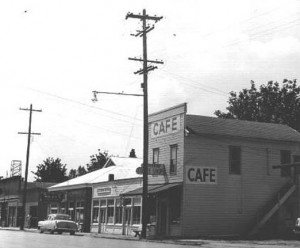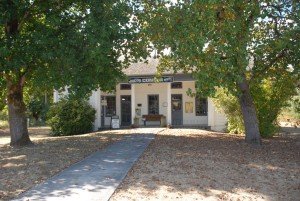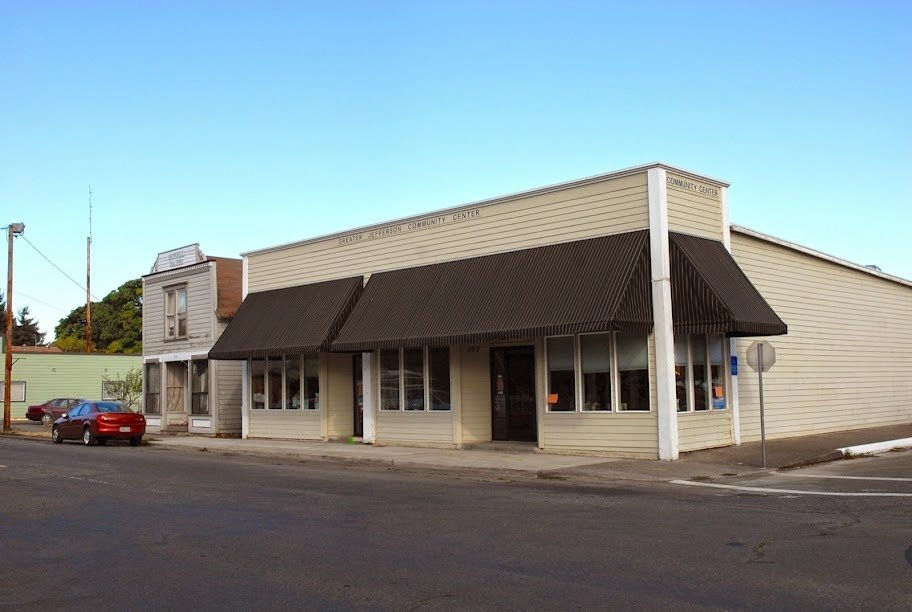 |
| Downtown 1961 |
In our first visit to Jefferson, two historic buildings on Main Street were the focus of our attention. Although we were eager to see the volunteer-organized Community Center, the 1854 Jacob Conser house, just across the street, is the most recognized site in Jefferson.
In 1848, Jacob and Nancy Conser and their two children traveled the Oregon Trail, following the Barlow Trail route to Oregon City and then taking up residence at the forks of the Santiam River near Scio. The Consers would eventually have ten children, eight born in Marion County. Conser’s experience in millwork served him well in Oregon. After one season at Santiam Forks, he moved downriver to Santiam City, where he established a sawmill in 1849. Santiam City, however, was susceptible to flooding—a flood in 1861 practically wiped out the town—so Conser took up a 640-acre claim in 1850 at the site of Jefferson, upriver from Santiam City. At Jefferson, Conser joined with James Bates, whose land claim abutted his, to build a substantial mill and millrace, which diverted Santiam water about two miles upriver from the town site. Conser also established a ferry at Jefferson in 1851, which quickly became the main crossing on the Santiam for wagon traffic south from Oregon City. By 1852, Jefferson had become the principal town on the river.
 |
| Conser House as City Library, 2012 |
Conser contributed substantially to building Jefferson, including the donation of land in 1856 for the Jefferson Institute, a private school for local children that emphasized classical education and continued until the formation of a public school district in 1899. He also participated in elective politics, serving as a Democrat in the Territorial Council in 1849 and in the House from 1852 to 1857. He was Marion County commissioner from 1850 to 1853, and he was Jefferson’s mayor in 1870 when the city was incorporated. Conser was also an incorporator of the Oregon Central Railroad Company in 1867. His home was Jefferson’s most substantial early residential building and served for many years after his death, first as the Jefferson Hotel and then as the town’s city hall and library.
In Jefferson, we found a quiet, rural community with an unusual amount of historical importance to our area of Oregon. Being on the north bank of the Santiam River gave it early river transportation. In the 1870s Jefferson profited by the main north/south railroad track going through the city. The city was still growing as commerce shifted to highways because the main north/south Highway 99E went right through downtown. However, when I-5 was created in the 1950s, it passed two miles to the east. With highway traffic shifting away, so did significant business investment. But Jefferson residents are proud of their city and support civic activities.
As visitors, we experienced this strong local volunteer spirit. One of these residents, local historian Mike Barnes, took us on a tour of historic houses, showing us that although Jacob Conser is the most celebrated past resident, there are a number of other 100 year-old homes along Main Street and the adjacent blocks. Mike’s tour illustrated the considerable Jefferson prosperity of the past. However, he pointed out local changes and losses. The ferry was long ago replaced by automotive and rail bridges, the latter in 1933 with an unmistakable Conde McCollough design. The imposing Marion-Linn Farmers Union Co-op, across the Santiam River, burned in the later 1950s. The 1914 rail depot of East Church Street, once a focus of freight and passenger service, is also gone. The elegant, 1910 three-story (with cupola) elementary school was razed, but another sizable elementary school replaced it.
Other volunteers have transformed the original 1906 Bank into a vital Community Center. We were impressed to see its many uses as it houses the Chamber of Commerce, several meeting rooms with limited kitchen facilities, areas for developing skills in crafts, a children’s playroom and a collection of memorabilia in its city museum.
However, plans are afoot to make a significant move for the historical museum. To the rear of this building, facing 2nd Street, a new city hall was completed in January of 2013. According to former mayor, Michael Myers, the new city hall complex will have a new city library as well. The city council working in concert with the “Friends of the Library” and have agreed to lease one half of the property to the Friends for one dollar a year for ten years. Friends are trying to raise approximately $800,000 for the new library. Once the library is completed the council’s plan is to work with the Jefferson Historical Society and restore the Conser House, the present city library site, to become a local historical center. Meanwhile, the owner of the nearby “Cafe 99” at 296 2nd Street offers a large collection of historic photographs on the wall and in albums for visitors to enjoy while enjoying a delicious lunch. Volunteer efforts such as these enhance Jefferson’s cultural activities such as those listed below.
The first Mint Festival was held in 1957 by the Lion’s Club that created the festival in celebration of the abundance of mint being farmed here. This gave the City of Jefferson the distinction of being named the “Mint Capitol of Oregon.” In 1958, as a “gimmick” to draw a crowd, Lions Club member Monte Weddle created the frog jump, which was modeled after the famous frog jump in Angels Camp, of Calavaras County, California. Rules were revised to fit Jefferson’s needs and Mr. Weddle served as the frog jump announcer for 25 years.
In July of 2012 the Festival celebrated the 55th anniversary of the Jefferson Mint Festival and the 54th anniversary of the frog jump.
On the first Saturday on May the Festival of the Flowers is celebrated. It was conceived to “celebrate the timeless beauty of the garden”, to showcase the organizations, non-profits and agri-businesses in the greater Jefferson area and to showcase historic Main Street.
For those visitors interested in Oregon National Register properties, there are three in the city. In addition to the Conser House (114 Main Street), there are the TM and Emma A Witten Drug Store & House at 104 Main Street and the 1871 Jefferson Methodist Church and Parsonage at 310-342 N 2nd Street.
The James Mechlin Anderson House is located at 728 Ankeny Hill Rd. James and Lucy Anderson, who initiated the building, were among the first settlers in upper Marion County. The couple settled their claim as early as 1848. His success in the California gold fields provided funding for the house that was completed in 1855.
The Hamilton Campbell House is more remote, sited on a hill off Route 1 near the airport. (A closed gate at the highway inhibits visits.) Campbell’s varied achievements included engraving the dies for the Oregon Exchange Company’s “Beaver Money” and design and construction of the Indian Manual Training School in Salem, the enterprise that became Willamette University. His three-story home was for many years the most imposing structure in the territory. He was murdered in Mexico in 1863, but his wife Harriet survived to 1902.
Jefferson is less than a half hour south of Salem. A visit there is not only a pleasant experience in Oregon history, but also an example of what civic improvements can be accomplished today by dedicated resident volunteers.
Each Tuesday, after a city was featured in that Sunday’s Statesman Journal, KMUZ broadcasted “Marion County 20”. You can hear the podcast listed on the KMUZ archives.

